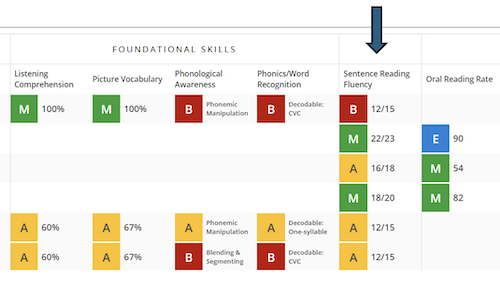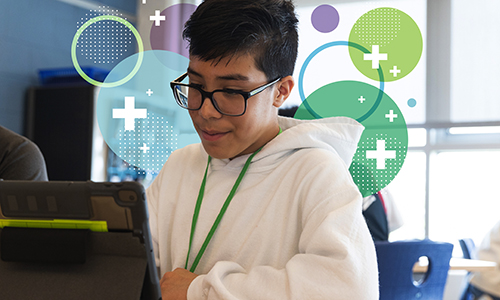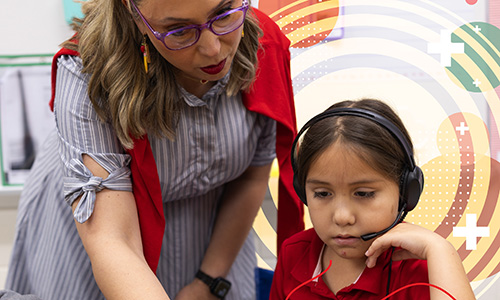 A confident understanding of assessment helps teachers meet their students’ needs early, when it’s easier to close opportunity gaps and pave the way to a successful academic career.
A confident understanding of assessment helps teachers meet their students’ needs early, when it’s easier to close opportunity gaps and pave the way to a successful academic career.
But it’s not just teachers who play an important role. School leaders must support their teaching staff in using assessment data effectively. Collaborating with family members and students is vital, too.
Together, we can all put assessments like MAP® Growth™ and MAP® Reading Fluency™ to the best use: to help kids grow.
Assessment literacy for school leaders
School leaders should have a deep understanding of assessment and assessment practices. It is only then that they can support their teachers and the entire school community.
A school leader should aim to do the following:
- Understand and advocate for the development of balanced assessment systems
- See learning target clarity and appropriateness as a foundation of sound assessment practices
- Offer professional learning to their teaching staff
- Recognize the faculty who become leaders and model accomplished assessment practices
- View the development of their own assessment literacy as a career-long learning process
MAP Growth and MAP Reading Fluency can be part of a district’s balanced assessment system. Our professional learning offerings are designed to support changes in goals and school improvement plans, changes in legislation, and required annual training. When we think about supporting teaching staff, it begins with understanding the why behind the assessments, how to administer the tests, and how to read the reports. That’s why we offer professional learning opportunities for MAP Growth and MAP Reading Fluency.
As a district administrator, I had to balance professional learning on new topics. However, I knew that if I didn’t provide professional learning on existing systems, my principals and teachers would think they were no longer important. When I joined one district, they bragged about how they used an assessment for over 20 years! However, new administrators and teachers were not trained, and the district had fallen into the rut of giving the assessment but never looking at the data.
Assessment literacy for teachers
When teachers have the assessment literacy support they nead from their leaders, it can be much easier for them to confidently use assessment data in their classroom. Teachers should focus on three assessment literacy goals:
- Continuously develop and hone their assessment literacy by participating in professional learning opportunities and communicating gaps in their knowledge to their principal
- Know how a school can promote and impede good assessment practice—and work to improve conditions to support good practice
- Support ethical assessment practices, as established by school or district leadership
Assessment literacy for teachers can feel more approachable if we break it down into six categories: assessment systems; assessment creation and alignment to learning targets; equity; using assessment data; collaborating with students, families, and colleagues; and continuous learning.
1. Assessment systems
Teachers well-versed in assessment systems
- Understand how instructional decision-making fits into a balanced system of assessment
- Are able to identify clear and appropriate purposes for each assessment
Teachers sometimes focus so much on summative assessment that they forget to connect it to formative and interim assessment. I saw this firsthand when I was working at a high school.
When the state assessment was first implemented at our school, we had some of the lowest scores in the state. A team of teachers met to develop formative assessments aligned to our summative assessment opportunities for improvement. We used the formative assessments to monitor student progress and adjust our instruction. Our high school improved scores on the state assessment by 26% in one year! We realized the summative assessment could be impacted within a strong, balanced assessment system.
2. Assessment creation and alignment to learning targets
Teachers working on creating assessments and ensuring all assessment is aligned to learning targets
- Are masters of the learning targets being assessed
- Can create and select high-quality assessments aligned to those targets
- Understand how school- or district-wide assessments mandated by leadership provide visibility into student progress toward meeting learning targets
I worked in a district where every English 10 teacher wrote their own end-of-unit assessment on a common novel. One longtime colleague administered a multiple-choice assessment, and I had students write an essay. A new teacher constructed an assessment with questions that aligned to standards, and she had question types that aligned to the summative assessment. When we met to collaborate, we realized that not only were we assessing different standards, but we were also assessing different processes. Our new teacher’s assessment quickly became a precursor to our transition to common formative assessments.
3. Equity
When teachers prioritize equity in assessment, they
- Make appropriate accommodations based on student need
- Employ a variety of assessment types that are appropriate for their students and learning targets
- Use formative assessment frequently to support student learning
When I was a district administrator, one of our focuses was on improving the identification of gifted students. We wanted the demographics of our program to match the demographics of our district, so we had multiple assessments to screen students. We did not have a universal screener, however. Once we implemented MAP Growth, we were able to improve the demographics in our gifted program.
4. Using assessment data
After an assessment is given, teachers should be able to
- Analyze the results in the larger context of what they know about their students
- Make instructional adjustments based on assessment data
In my current role at NWEA, I have helped support 50 schools with PLCs in Georgia. Their chief of schools wanted teachers to use MAP Growth and MAP Reading Fluency data immediately to inform their instructional practices, so she developed a professional learning schedule in which school administrators receive professional learning during each testing window while school-level PLCs take part as soon as the testing window closes.
The district had been providing professional learning to administrators for many years, so my colleagues and I were surprised when teachers shared that they never used the MAP Growth learning continuum. When we showed teachers their state standards connected to RIT scores, they began to understand how to connect the data to their curriculum and standards.
5. Collaborating with students, families, and colleagues
When working with others to support the growth of all kids in their classroom, teachers should
- Understand how to tailor the communication of results to meet the needs of students, their families and, when appropriate, their other teachers
- Teach students how to use their assessment results to take charge of their learning success
- Partners with families and colleagues to identify learning needs that can be best met collaboratively
When students understand their assessment data, they often put more effort into taking an assessment, which provides more accurate data. I remember working with a California school focused on goal setting with students. They used the Student Profile report to show kids how better-than-average growth would improve their achievement percentiles, and they used this information to set learing goals with them. One educator even created goal-setting templates teachers and students could use during conferences. These and other supports can be found in our Teacher Toolkit.
I think student goal setting is a great compliment to student-led conferences. When students can explain their assessment results to their families, it’s easier for them to get the support they need at home.
6. Continuous learning
A teacher focused on continuous learning
- Sees the development of assessment literacy as a career-long learning process
- Advocates for sound assessment practices in instructional and/or policy settings
A teacher recently emailed me with a question about her students’ MAP Reading Fluency scores. She wanted to make sure she was interpreting them appropriately. She was triangulating her MAP Growth, MAP Reading Fluency, and other data, and she wanted to make sure her interpretation was correct. She also included other data, such as attendance, because she knew so many data points were impacting her student’s learning. She’s been an educator for more than 20 years, and I love how she continues to passionately engage in professional learning.
Assessment literacy for families
With support from their child’s principal and teachers, family members can
- Understand how assessment information can be used to strengthen partnerships for student success
- Understand that students are entitled to clear targets, quality assessments, effective communication of results, and equity of motivation
- Assertively protect the rights of students
- Advocate for sound assessment practices
Many schools have processes in place to share assessment data in meaningful ways. One district I work with provides professional learning to administrators and teachers on how to partner with families. They’ve developed the professional learning from resources found in our Family Toolkit and our Teacher Toolkit, which includes templates of letters about MAP Growth and MAP Reading Fluency. In addition, the district has provided written expectations for sending communications to families and using the Family Profile report during conferences.
Assessment literacy for students
When students are empowered to get the most out of assessment, they can
- Become advocates for student involvement in their learning and using assessment as a teaching and learning strategy
- Understand why they’re being assessed
- Know what knowledge they’re trying to master
- Get accurate information about their learning progress
- Have the opportunity to ask for and receive the information they need to grow
- Feel they have an important role in promoting their own success
This spring, at an elementary school I was visiting, the principal proudly showed me a data display. Students had placed leaves with the number of RIT points they had grown during the school year on a paper tree. Educators there had spent the year explaining to students that they were taking MAP Growth to help their teachers identify how best to support their learning. In winter, teachers had shared their growth targets with each student, and many took the time to set goals with their students. Their hallway data tree was a public celebration of their progress.
In closing
Developing and promoting an assessment-literate school culture is a shared responsibility. Whatever role you play, taking initiative in advancing your own expertise and helping others understand the principles of sound assessment practice can go a long way in helping all kids reach their potential.






